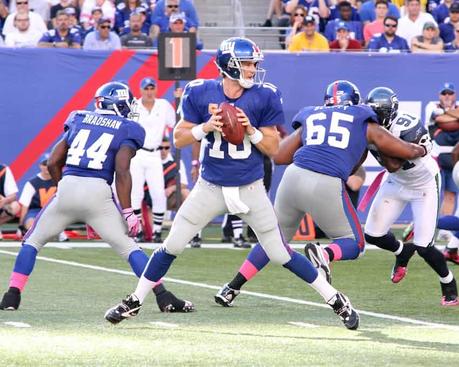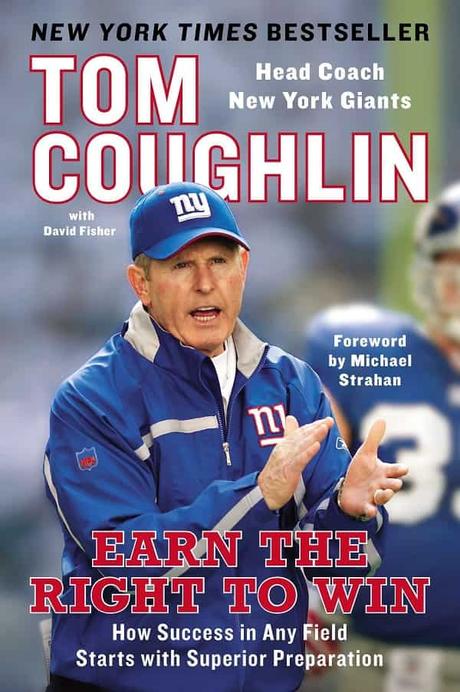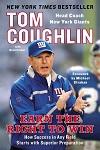 Image credit: Mike Rizzi | Flickr
Image credit: Mike Rizzi | Flickr
Tom Coughlin was a three-time Super Bowl winning coach.
His book, Earn the Right to Win: How Success in Any Field Starts with Superior Preparation, is a leadership book for coaches and athletes that emphasizes preparing like a champion in order to perform at the highest level possible.
Coughlin’s philosophy and outlook are no nonsense: create a process for your team that is clear and simple, have rules and guidelines to govern performance, and be willing to work harder than the competition.
Sounds simple to do, but not always easy to do.
Coughlin’s book is essential reading for coaches and leaders. The lessons and strategies are applicable on and off the field.
Coughlin breaks down his leadership principles, adding in stories and anecdotes, mostly from his time as head coach of the New York Giants. As head coach, he took the Giants to the Super Bowl twice, both times beating the best football team of the last few decades, the New England Patriots.
Below are a few of the leadership lessons that I took from Coughlin’s Earn the Right to Win. Included are some key quotes, passages, and notes and thoughts of my own.

Where to Buy – Earn the Right to Win by Tom Coughlin
Paperback | Kindle | Audiobook
Earn the right to win.
When you plan properly, when you establish clear guidelines and rules for the team, and when you are willing to work your ass off and use adversity as teaching moments, you find yourself in a position where you have earned the right to win.
- “We didn’t get there by luck; we got there by hard work and sacrifice, by following a plan. The phrase we use to describe that feeling is ‘earning the right to win.’”
Sharpen the focus on what you want to achieve.
Murky goals encourage murky effort. Before launching yourself down the path of a new season, training cycle, or even your daily workout, be clear about what it is you are setting out to do. Vague goals don’t invite the kind of commitment required to be successful.
- “The first thing you need to do—always—is clearly define your goal… Start by identifying the end. Be as specific as possible.”
After you have a clear target in mind, “you can begin outlining the steps you’ll have to take to get there and what you have to do to take each step. Like almost everything else in life, it is a process.”
The definition of winning is based on your effort.
Winning isn’t as simple as what the scoreboard says, even though that tends to be the measuring stick for victory and defeat.
- “Winning is what happens when commitment, desire, talent, preparation, hard work, and leadership all come together. There are few things that match the feeling of satisfaction when you know you’ve done your job to the best of your ability.”
Successful teams and organizations have clarity of structure and purpose.
Team members know what their duties are and what they are responsible for. Legendary coach Bill Walsh, three-time Super Bowl winning coach with the 49ers, had his Standard of Performance, which he outlined in his book, The Score Takes Care of Itself, that clearly outlined the duties, responsibilities and expectations of each team member.
Reflecting on his early coaching days at Syracuse University, Coughlin noted that “everything we did every day was detailed. So when something wasn’t done, or it went wrong, it was simple to discover the source of the problem and correct it.”
- “People need to know what they’re going to get every day they show up for work.”
- “The structure is a statement: This is who we are, this is what we do, and this is the way we do it.”
The process comes with a fair amount of uncertainty.
Be willing to commit to your process and withstand the challenges and adversity ahead. Avoid the urge to jump ship or completely change course each time there is a hiccup.
Because there will always be hiccups—no matter how deeply you plan, your preparation will get sidetracked and tested. Your challenge is to maintain commitment to the process.
- “The road to success has a lot of potholes, and if you changed direction every time you hit one of them, you’d never reach your destination.”
Make a decision, and stick to it.
People will second-guess your decisions, knock your choices, backseat drive your actions. In starting rookie Eli Manning in the middle of the season, replacing established veteran Kurt Warner, Coughlin got plenty of flack when the transition didn’t start out smoothly. (The Giants scored just 37 points in Manning’s first four games.)
- “Once I’d made that decision, I never wavered. While I didn’t read the newspapers, I certainly was aware of the criticism about my decision. It would have been impossible not to. But once I had made it, unless something drastic happened there was no way I was going to change it… Making it work required a commitment to stay the course.”
Structure in your process and in your team provides stability during adversity and uncertainty.
That first step into a new structure and process can feel uncertain. You are stepping into the unknown. While you may feel confident in your chances, there is no guarantee of success. That’s why structure is so helpful—it gives you something reliable and consistent that can be relied upon when doubt, uncertainty, and adversity strike.
- “The structure that would eventually lead to success was in place. We hadn’t won, but we had established the parameters that would enable us to become the best team we could be. The first step was done.”
A team is only as strong as the rules that govern it.
The benefits of having clear rules in your organization:
- Defines the culture: “The culture of an organization is defined by its rules. The rules are used to set the tone and the expectations.”
- Rules provide order: “Rules are like the traffic lights of real life: If you don’t have a set of rules by which everyone abides, you have chaos, there is no structure, and you lose.”
- They sift out who is serious and who isn’t. “Setting tough rules is also a good way of finding out quickly who is committed to the program and who isn’t, who’s going to buy into our philosophy and be willing to pay the price and who wants out, who is in the trenches with us when it gets tough and who isn’t.”
- Rules enhance a sense of professionalism and pride: “They are designed to bring the team together, create a professional environment in which we can get all our work done with a minimum of distraction, and help develop pride in the organization.”
Adversity provides opportunities for hyper-improvement.
Successful teams and high-performing athletes use adversity, mistakes, and setbacks as springboards for improvement. Adversity, when framed correctly, is an invaluable teacher for how to improve.
- “There will be times when we all have to overcome adversity—but we believe adversity makes us stronger.”
- “How you overcome those obstacles will go a long toward determining whether or not you’ll be successful.”
Character wins over talent
In every team there is the group of high-performers, the athletes who are self-motivated, require little supervision, and pull the majority of the team along with their effort and example.
Urban Meyer, three-time national football college champion, called this group the 10 percenters in his book, Above the Line. And then you have the bottom 10 percenters, the ones who complain, who are indifferent, who threaten to pull down the team.
Coughlin recognizes that the success of the team can be significantly impacted by the athletes and coaches who have a bad attitude. Talent doesn’t make up for bad character.
- “Your success as a team is going to be greatly hampered by someone who, by virtue of his attitude, is not willing to do what is necessary for the good of the team.”
- “No matter how talented a player may be, you can’t ignore a lack of character or pretend it isn’t going to affect your entire program.”

Paperback | Kindle | Audiobook
